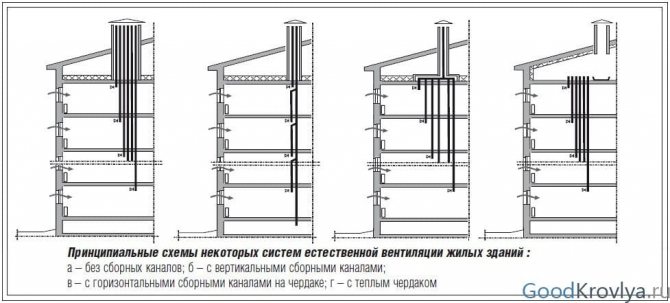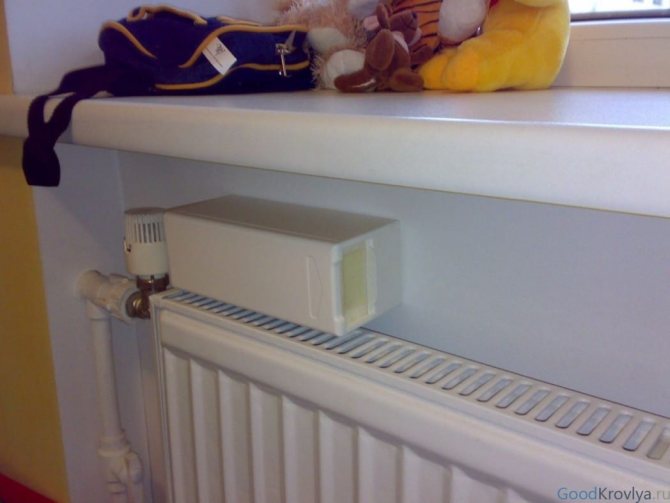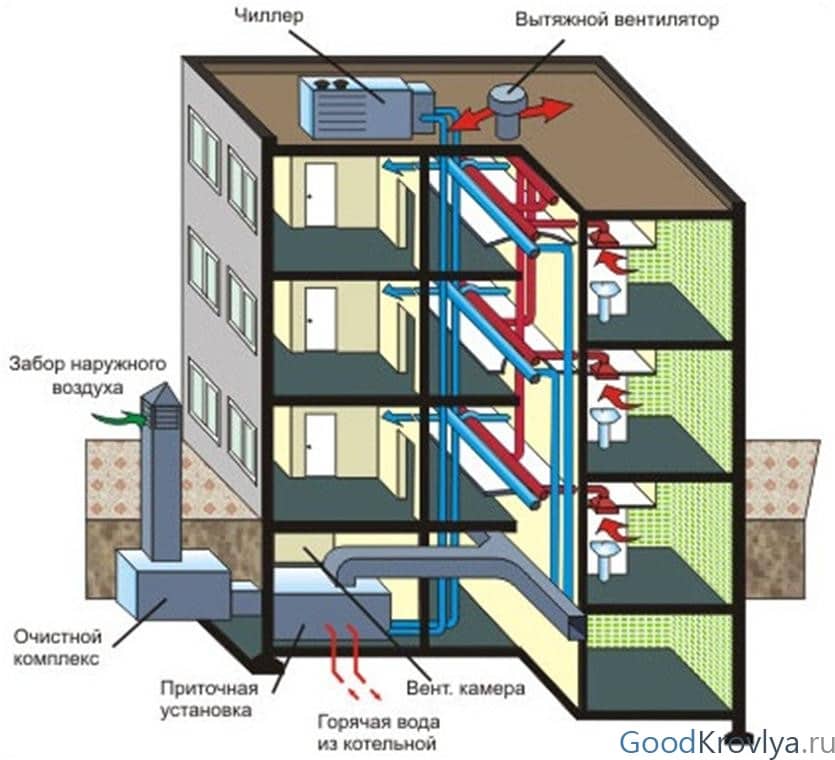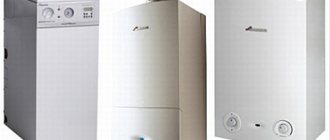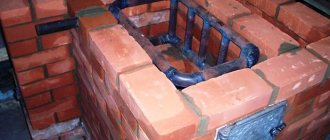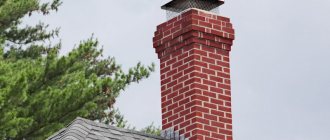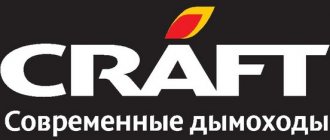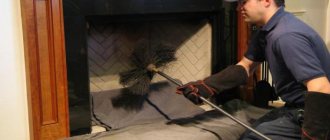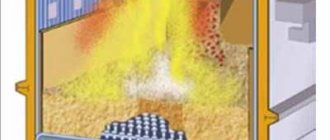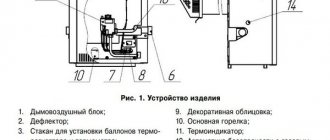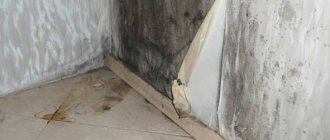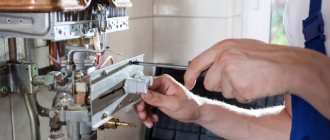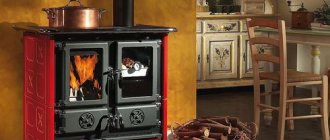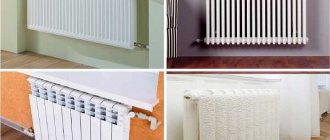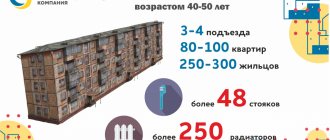The need for arrangement of smoke and ventilation ducts
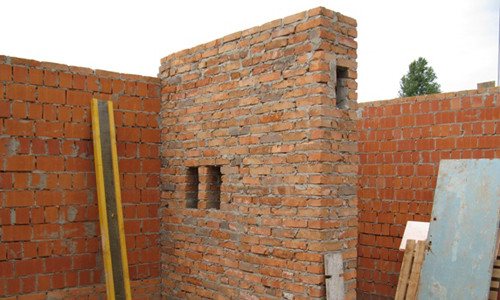
The laying of ventilation and chimney must be done at the stage of wall construction
Adequate ventilation is air circulation, in which enough fresh air enters the room and the waste masses are removed.
In modern dwellings, it becomes more and more complex. This is due to the equipment of apartments with plastic windows. The sealed structures reduce heat loss and protect against noise, but impede microcirculation. As a result, the natural hood cannot cope with air exchange. The dwelling has to be equipped with additional ventilation ducts or ventilated forcibly.
For stove or boiler heating, separate chimney ducts are needed, serving only the heating unit. Combustion of 1 cubic meter of natural gas requires 10 cubic meters of oxygen. It is impossible to take such a mass of air from the room. The supply of oxygen and the removal of combustion products are provided by chimneys.
Checking act
What does the chimney or ventilation duct inspection report include? Let's list its points:
- Date.
- Name of the person who conducted the survey.
- The name of the object where the inspection was carried out.
- Position and name of the person representing the object.
- The legal details of the entity that owns the object.
- A list of factors that were assessed - from the availability of the necessary documentation to checking the state of the microclimate.
- Conclusion.
We recommend that you familiarize yourself with: Dome hood 60 cm wide
When might this act be required? Many organizations, including gas service, housing inspection and UGPS, may want to look at this document during one of the inspections. Its absence will entail legal consequences that any of us would like to avoid.
For such cases, a special package of documents should be prepared, including:
- Completed act with a special hologram.
- A copy of the license issued by the Ministry of Emergencies, with a seal.
- Copies of protocols confirming the level of training of the specialists who carried out the inspection.
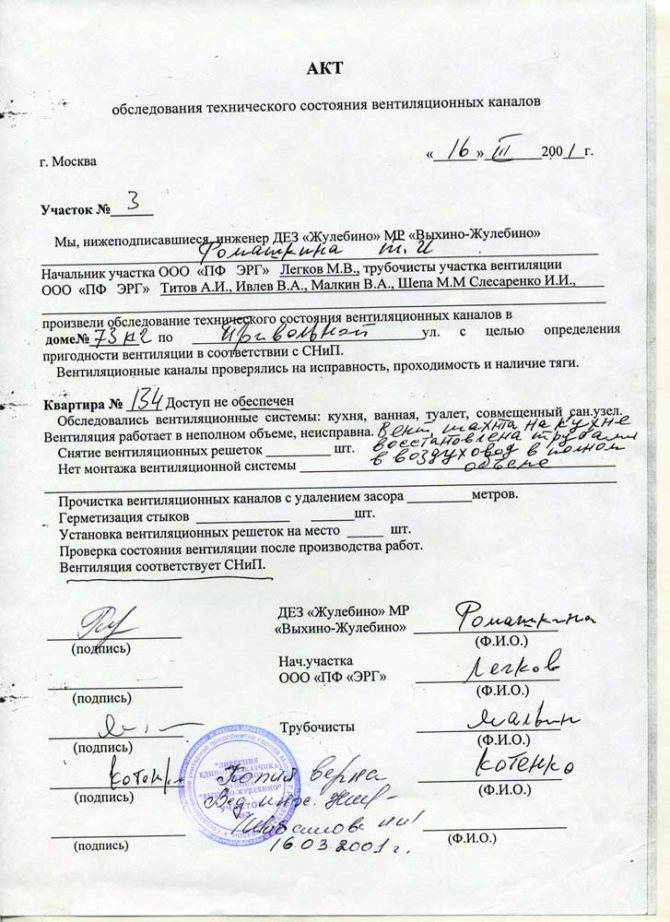

Requirements and norms
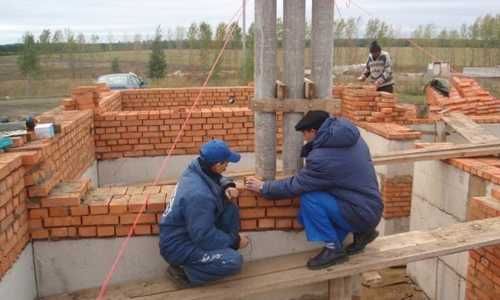

Mainly vertical ducts are used for ventilation.
A number of documents regulate the construction of ventilation and chimney ducts: SNiP "Heating, Ventilation and Air Conditioning", SNiP "Gas Supply", "Safety Rules in the Gas Industry" and many others.
Based on these documents, a building ventilation project is being developed. Calculations are made taking into account the amount of required air exchange. For a living room, 3 cubic meters of air is enough for 1 hour per 1 square meter. m area. For bathrooms, this value is much higher - up to 25 cubic meters. For a kitchen, at least 60 cubic meters are required. m. per hour, and if the gas stove is working - 100. Cooking in the kitchen with metal-plastic windows is possible only if there is a hood, since it is very difficult to arrange such powerful natural ventilation.
Requirements for ventilation ducts:
- The fewer the horizontal parts, the more efficient the ventilation. If forced, the horizontal fragments can be quite long, turns are allowed.
- A circular section is more efficient than a rectangular one. It is preferable to use pipes, the minimum diameter is 120 mm.
- Ventilation openings must be placed at a distance of no more than 10 cm from the ceiling.
- The minimum length of ventilation ducts made of heat-resistant bricks is 12.5 cm - half of an ordinary brick.
- The height of the shaft head depends on the distance to the ridge.
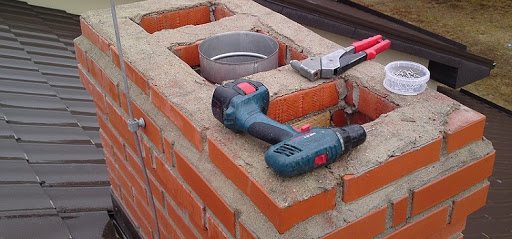

The chimney must be sealed and withstand high temperatures
Additional requirements are imposed on the chimney ducts.The combustion temperature of the fuel is very different. In addition, firewood, coal, even gas often do not burn completely, with the release of aggressive acidic residues. This is taken into account when choosing.
- The flue duct must be absolutely sealed and not in contact with the air of the room through which it passes.
- The structure must be strictly vertical.
- The flue material must withstand the combustion temperature of the fuel and the action of aggressive substances.
Ventilation and chimney ducts must be periodically cleaned; this requirement is taken into account when developing a project.
Chimney and ventilation requirements
The need for a ventilation device and the norms for its calculation are contained in SNiP 31-01-2003. It contains air exchange rates for different categories of premises. So, for living rooms, this value is small - 3 cubic meters per hour per 1 sq. square meter. But for bathrooms this figure is already higher - 25 cubic meters per hour. The highest air exchange requirements for kitchens: 60 m3 / h for a kitchen with an electric stove, and 100 for a gas one.
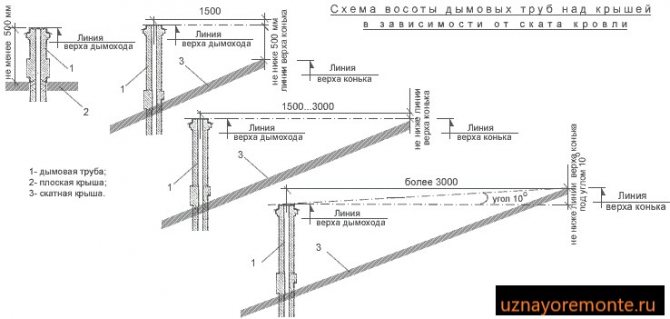

Thus, the rooms from which the exhaust air must be discharged in the first place are bathrooms, toilets, laundries, boiler rooms and kitchens. At the same time, the presence of mandatory ventilation is established by regulatory enactments, if you use gas equipment in an open fire: it is strictly forbidden to install the stove in a room without ventilation. For equipment with closed fireboxes, a separate chimney must be provided and an air supply must be provided.
Chimneys are subject to stringent requirements, which are set out in SP 7-13130-2013. This is especially true for fire safety, because the temperature range in which they are operated is quite large. There are several regulations governing the operation of gas equipment:
- SNiP 31-01-2003;
- SNiP41-01-2003;
- SNiP 42-01-2002;
- SP 31-106-2002;
- SP 42-101-2003.
After analyzing these documents, a number of conclusions can be drawn regarding the arrangement of smoke channels in the house:

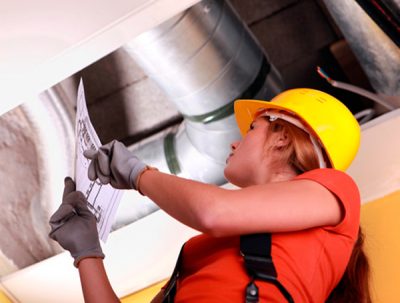
Tightness of execution. The channel should not communicate with the rooms through which it passes.- A limited set of materials from which the chimney can be made.
- The dimensions of the room where the heating device can be located are regulated: its area should not be less than 7.5 square meters. meters and the minimum ceiling height in it is 2 meters.
- The flue duct must have an even inner surface, without protrusions and recesses.
- Ventilation systems and exhaust systems for heating gases must be checked and, if necessary, cleaned.
Thus, the normal operation of the smoke and ventilation ducts depends on two factors. The first is correct design. The second is the quality of workmanship during construction.
Technical features of channel laying
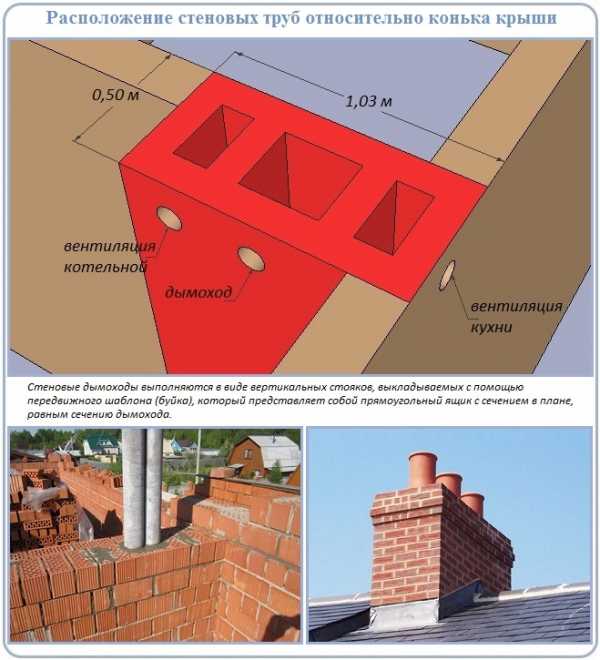

It is recommended to lay the chimney parallel to the ventilation ducts.
The construction of canals is carried out in accordance with the rules of SNiP:
- The construction of air ducts of any type without an approved project is strictly prohibited.
- Brickwork of both smoke and ventilation ducts is prohibited. They settle down separately.
- It is recommended to install the ventilation duct parallel to the chimney. The combustion products heat the air in the ventilation duct, which improves traction.
- The masonry depends on the thickness of the wall. With a size of 380 mm, the masonry is single-row, with a thickness of 640 mm - double-row.
The dimensions and nature of the masonry depend on the power of the heating system, the area of the room, and the purpose of the building. This is important when building a brick channel: after all, its parameters depend on the parameters of the brick.
System design options
Ventilation ducts in a private brick house may have a different device. A design is chosen taking into account the characteristics of the rooms and one common feature for the hood. Heat is also removed along with the exhaust air.To prevent cooling, a brick ladder bend will be included in the ventilation system. It creates a barrier and prevents the premature removal of heated air: having lingered, the air flow has time to partially transfer heat into the room.
Conclusions from the premises
This design is used to equip complex ventilation. In the upper part of the building, all channels are combined into a common shaft and led out through the roof, like a chimney. Its height and diameter depend on the volume of the premises and the distance to the ridge of the roof.
Wall pipe
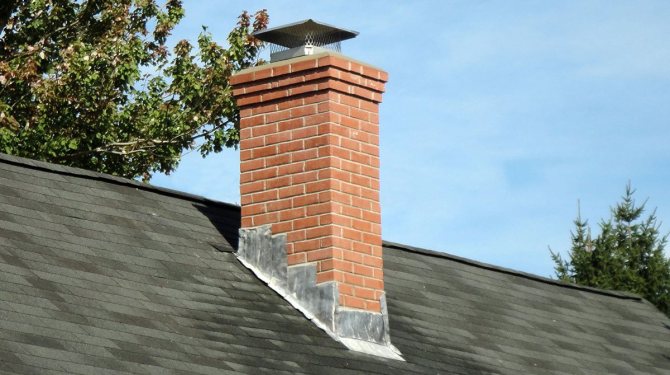

Brick chimney is mounted in the inner walls
The air duct is equipped directly in the inner wall. Installing ventilation ducts, and even more so chimney wall pipes in the outer walls is allowed only in exceptional cases. The wall is in contact with cold outside air. At the same time, the exhaust gas, passing through the air duct, cools faster and does not warm up the room properly. For the same reason, condensation quickly forms inside the chimney or ventilation duct itself. This reduces thrust and accelerates wear as acid anhydrides precipitate on the shaft walls. The wall pipe in the outer wall must be additionally insulated.
A separate chimney is installed for each stove. In exceptional cases, equip 1 chimney for 2 stoves. The ventilation duct is installed for every 2 chimneys.
The chimney pipe ends at the top floor and turns into a regular chimney. The height of the chimney and the head of the ventilation duct depends on the exit point.
Root pipe
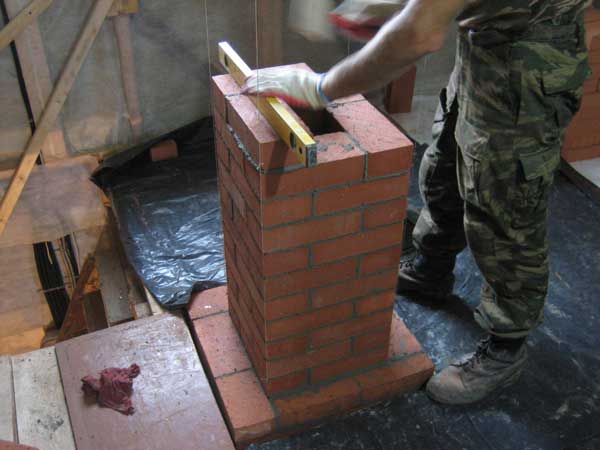

Brick chimney on its own foundation
It is usually set up in wooden buildings. A brick chimney is erected on its own foundation, and the latter does not adjoin the foundation of the building. The wall thickness is equal to half a brick.
The root pipe can be connected to two hearths. For this, crossover sleeves are installed.
Attachment pipe
It is built directly on the furnace. Experts recommend placing a brick chimney not directly on the neck of the furnace, but after laying a reinforced concrete slab with holes on it. This device allows you to repair the stove in the future without disassembling the chimney.
Primary requirements
For each stove, as a rule, a separate chimney or duct (hereinafter - chimney) should be provided. Since with the simultaneous heating of two stoves, the stove on the lower floor, with a stronger draft, will interrupt the upper one, preventing the free exit of smoke from it.
It is allowed to use a common chimney for two stoves installed on the same floor, provided that a cut is made in the form of a transverse wall between chimneys at a height of at least 75 cm. In this case, the minimum cross-sectional area of the common chimney channel must be at least 1x0.5 bricks.
In houses with stove heating, it is not allowed: a) the device of exhaust ventilation with artificial induction, not compensated by an inflow with artificial induction; b) exhaust of smoke into ventilation ducts and installation of ventilation grilles on the smoke ducts
Chimneys should be located in the inner walls of the building. Laying them in external walls is less economical and creates difficulties in operation. Passing through the chimneys in the outer wall, the gases give off part of the heat to the unheated room, and in the atmosphere, due to the low temperature of the ambient air, the gases cool excessively, which impairs draft. At the same time, resinous substances are released from the gases, which penetrate through the masonry and are deposited on the external structure of the house.
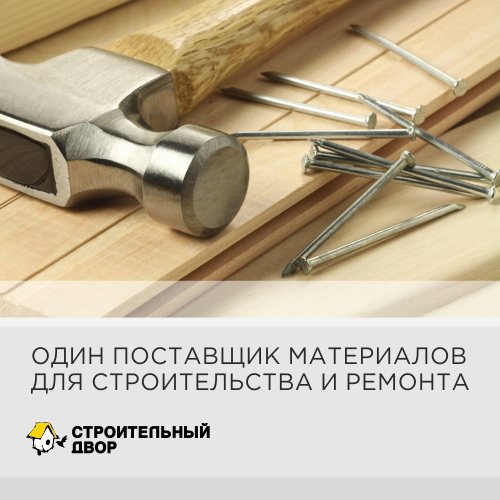

In the event of a forced location of the chimney stack in the outer wall, the chimney wall must be thickened. The thickening of the wall is performed in the form of pilasters (square or rectangular protrusions on the wall).
The minimum thickness of the masonry between the chimney and the outer surface of the wall is taken depending on the design temperature of the outside air:
- at t = -20 ° С and above - 38 cm (in 1.5 bricks)
- from t = -20 ° С to t = -30 ° С - 51 cm (in 2 bricks)
- from t = -30 ° С and below - 65 cm (2.5 bricks)
For laying the foundations of stoves, hearths and chimneys, the same materials are used as for the foundations of a house, for the main masonry of stoves, hearths, chimneys and channels in the walls - ordinary clay brick (full-bodied).
If the walls are lined with silicate bricks, cinder blocks, etc., areas with smoke channels should be laid out of ordinary (full-bodied) clay red brick.
Materials for smoke and ventilation ducts
The air ducts are under heavy stress. Warm air comes out through the shaft. When in contact with cold outside air, the gas inside quickly cools. Since its humidity is noticeably higher, condensate is deposited on the channel walls. In this case, the difference between the temperature inside the ventilation duct or chimney and the temperature outside becomes even greater.
Unoxidized combustion products, acid anhydrides and oxides are removed with the exhaust gas. When condensation occurs, they turn into acids and destroy the wall material. So the latter must be resistant to temperature and acids.
Brick
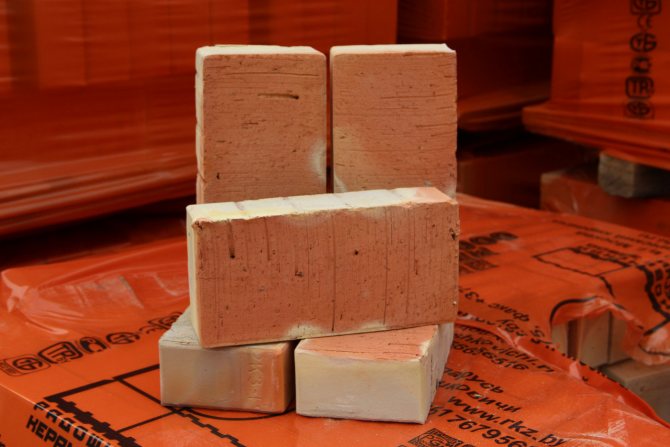

Solid ceramic bricks withstand high temperatures
A brick ventshaft is a traditional solution. Ventilation and chimney ducts of any kind are constructed from building stone. When arranging, the following rules are followed:
- Not every brick is resistant to temperature. For chimney channels, only full-bodied ceramic is taken. Silicate and hollow temperature changes do not withstand and is unstable to the action of acids.
- The section of the shaft is rectangular, which reduces traction. You need to accurately calculate the height of the pipe.
- The inner surface of the duct is carefully leveled. The smoother the surface, the less soot, soot, and sulfur oxide are deposited on it.
- Tightness is a prerequisite. This is also true for ventilation, since with cracks, irregularities, good traction cannot be achieved.
The laying of brick ventilation ducts and chimneys is paid at high prices compared to the construction of a partition.
Prefabricated single-circuit galvanized and steel systems
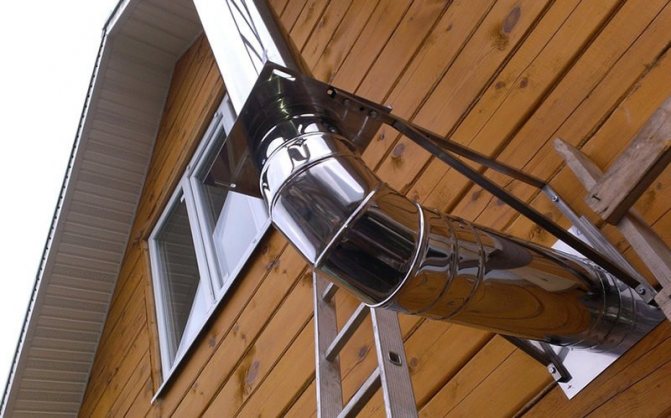

Steel chimney with one elbow when leaving the boiler
With high ceilings, wall piping is not possible. It is also almost impossible to draw up an effective overall ventilation scheme if the building is intended for rent, as each owner has his own needs. In this case, single-circuit systems are mounted.
The structure is assembled from metal pipes and elbows. The connection is sealed - in a lock or on screw connections. There are round and square pipes. The first ones are taken for the chimney, the second ones for ventilation, where the traction force does not matter so much.
There are several restrictions:
- The chimney can only include 1 elbow - when leaving the furnace or boiler.
- The pipe gets very hot. It can be laid in a brick or stone wall, but not in a wooden one. If the pipe is not hidden, it is thermally insulated to prevent fire.
- You cannot take galvanized steel for the chimney: the alloy actively interacts with acids and will quickly fail. The best option is stainless steel.
The service life of a single-circuit system is short - up to 15 years. However, it is very easy to replace the pipes.
Dual-circuit systems
Chimney option. The system includes 2 steel pipes - for the air supply and for the removal of combustion products. The pipes are insulated from each other and from the outside air with mineral wool. The system is fireproof and lasts much longer. Due to thermal insulation, less condensation is formed.
Asbestos cement pipes
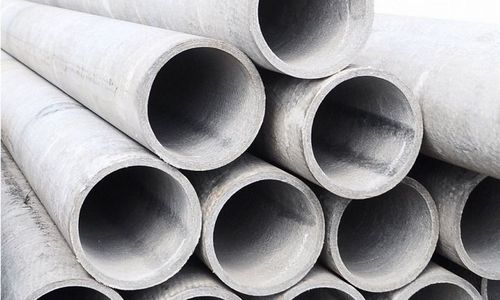

Asbestos-cement chimney pipes
Not too resistant to temperature, but insensitive to the action of chemically aggressive substances. The cost is low. Suitable for the construction of ventilation ducts and chimneys for devices with low temperature output.
Asbestos-cement pipes are inconvenient: installation of corners or transitions is impossible, the material is fragile, it is difficult to work with it.
Sand cement pipes
Such mines are built from a special type of building blocks. Their shape is traditional - 20 * 20 * 40 cm, but they include 1, 2 or 3 channels. Sizes can be large. The blocks are used in the construction of wall ventilation. They are not suitable for a chimney, since they are rarely of sufficiently high quality and do not always provide tightness.
Prefabricated ceramic systems
They consist of a round ceramic tube, mineral wool insulation and a concrete cover. Such blocks are easy to install, serve for a very long time and are very promising. The downside is the high cost.
Ceramic systems are used in the construction of chimneys, such ventilation is too expensive. If desired, the blocks can be built into the wall and hide the chimney.
Corrugations
Corrugated steel pipes allow the construction of complex exhaust systems, where it is impossible to do without turns and transitions. They are often used as sleeves and to connect wall chimneys with boilers. A corrugated pipe is not suitable for smoke extraction: a lot of soot and soot is deposited on such a wall, the pipe quickly breaks down.
Polymer pipes
They are of limited use. Plastic is not characterized by high heat resistance, therefore, they are used for exhaust and for chimney removal from boilers on liquid fuel or gas: there is a relatively low combustion temperature of fuel.
Plastic pipes are used to modify an old brick chimney. Introduced into the channel as a sleeve.
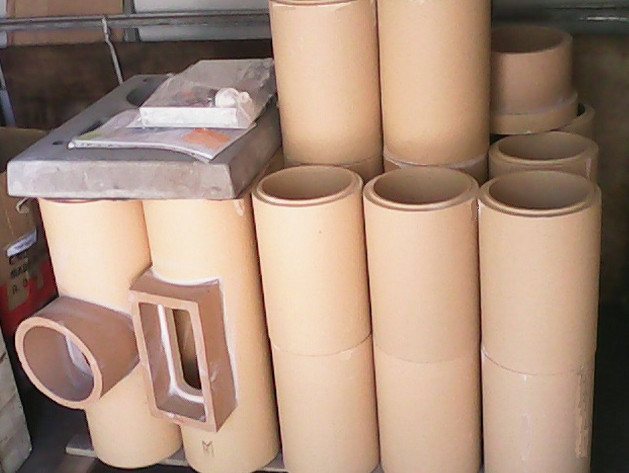

Ceramic pipes
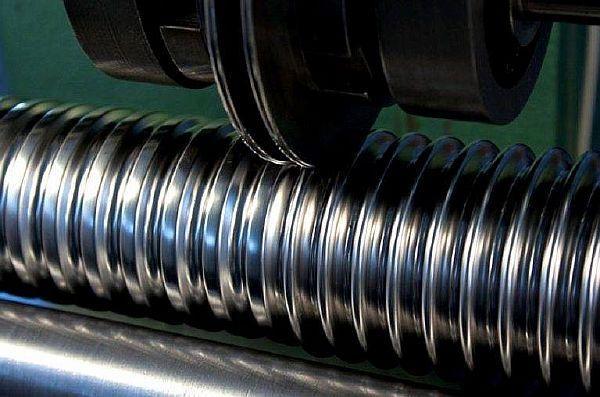

Corrugated stainless steel
Step-by-step instructions and do-it-yourself installation nuances
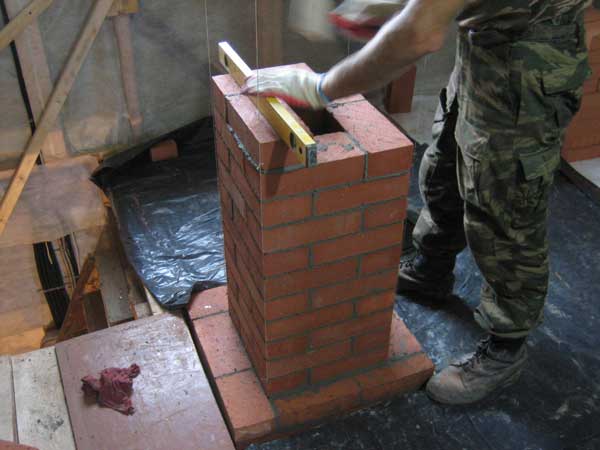

The brickwork must be flat so that the metal pipe inside does not deform
To achieve a high-quality result, at the first stage of construction, a chimney diagram is drawn up and the necessary calculations are made.
The most difficult thing is to build a channel from bricks. The process is long, difficult, requiring interruptions for the masonry to shrink. If the chimney is light, it is placed on top of the stove. When the structure passes through several floors, it is placed next to the oven and connected with an adapter.
Do-it-yourself brick chimney is done in the following sequence:
- Solution preparation. Clay, lime and cement are used.
- Laying out the attachment base with tying each row.
- Inner pipe outlet with opening for damper.
- Passing the ceiling, making fluff.
- Laying out the external channel, arranging the second extension (otter).
In conclusion, the gaps are sealed and the head is installed.
It is much easier to assemble ceramic flue pipes. The assembly uses ready-made elements that need to be connected, sealed and securely fastened. The work is carried out in the following sequence:
- Manufacturing of a refractory base with a branch pipe.
- Phased installation of the pipeline in the socket. At the same time, the joints are sealed with a heat-resistant sealant.
- Securing the highway to walls and attic structures.
- Thermal insulation application.
- Installation of external finishing, installation of the head.
When building from ceramics, the general rules for chimneys must be observed - to install inspection hatches, condensate collectors, protection of floors with a special apron.
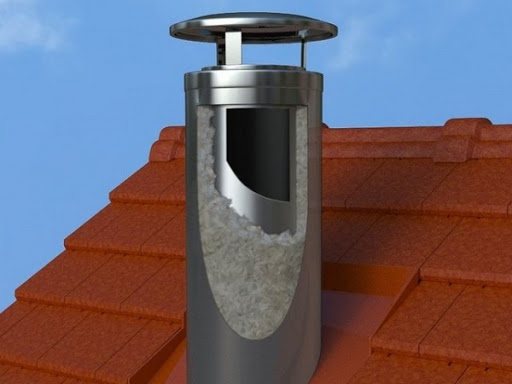

You need to put a cap on the chimney from the sandwich pipes.
A sandwich-type pipeline is also made from ready-made links, which are inserted into one another.
The assembly of a stainless steel chimney is carried out in the following order:
- Manufacturing of a base with a branch pipe.
- Assembly of the line with simultaneous isolation of the connection points. A sealant or clay-impregnated asbestos cord is used.
- Laying a chimney through a wall or ceiling.
- Fixing communication to walls and roof.
- Installation of the head.
Having built a chimney with your own hands from an iron pipe with insulation, you can not worry about its additional finishing. The product does not actually heat up; it can be laid through a wooden ceiling without installing an apron.
Installation of smoke and ventilation ducts
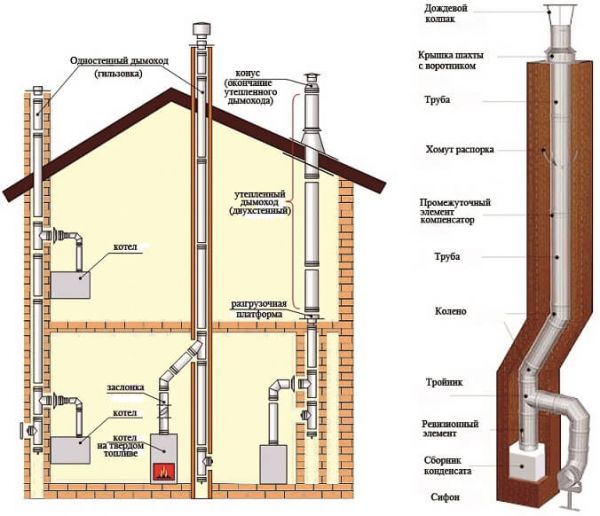

The chimney should be located at the highest point of the roof
Chimneys and ventilation ducts in masonry work only under one condition - sufficient draft. It arises due to the difference between the air pressure at different heights. In a one-story house, it is very small, but this is enough to ensure that the more rarefied heated air is drawn out.
To provide traction, the following requirements are met:
- The ventilation and chimney pipes go out to the roof and reach a certain height. The value depends on the distance between the exit and the ridge. If the distance is less than 1.5 m, the pipe should be 50 cm higher than the ridge; if from 1.5 to 3 m, it should be level with the ridge. If the distance is more than 3 m, the height is calculated: the line from the ridge to the pipe head is 10 degrees below the horizon. If there is a parapet on the roof, there is a higher structure nearby, the height of the pipe is increased.
- The ventilation ducts can be combined. Chimneys are combined only in exceptional cases - when constructing a stove with a fireplace.
- If the chimney ducts are not located in the wall, they are insulated along their entire length. Any conclusions in the places of transition through the roof are insulated. Use asbestos or safer mineral wool.
It is recommended to waterproof the pipe between the roof and the otter. If this is not done, the entire wall will get wet.

